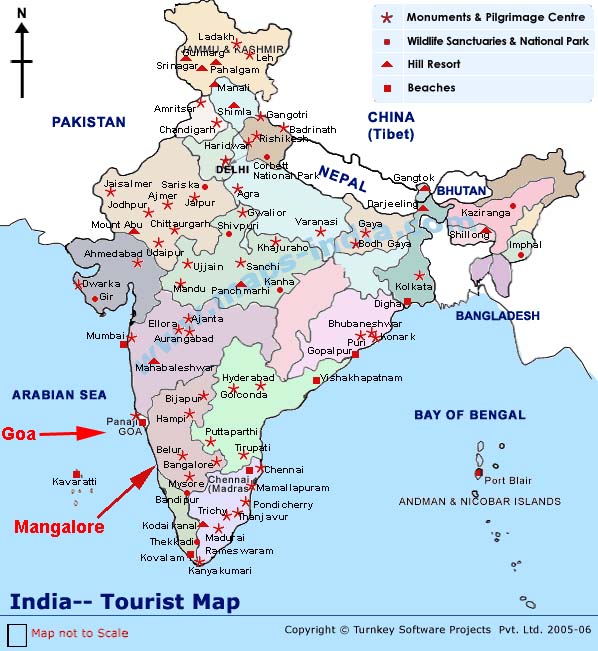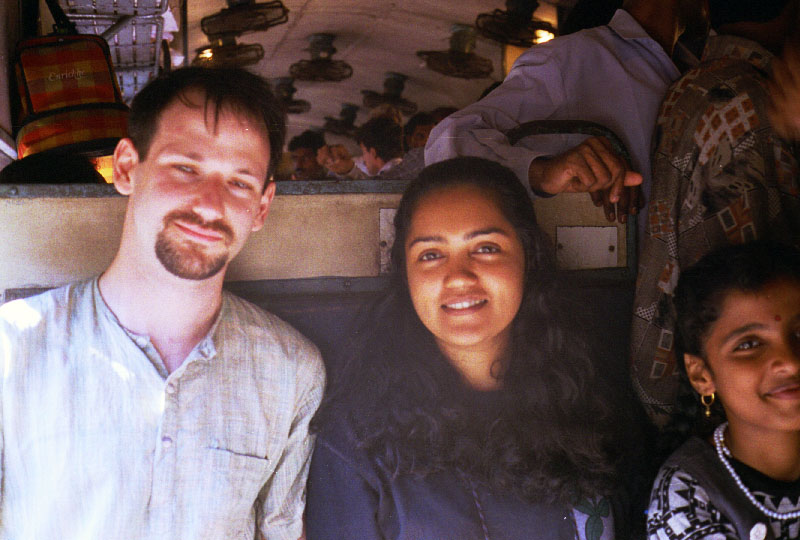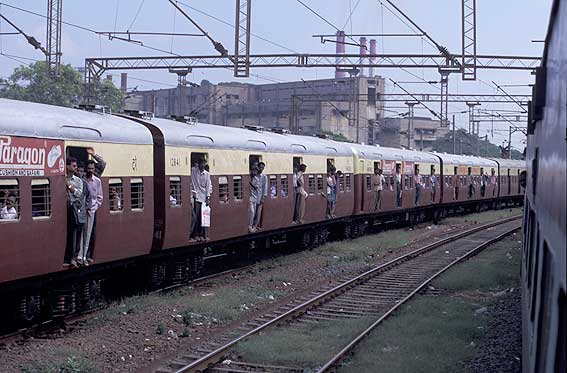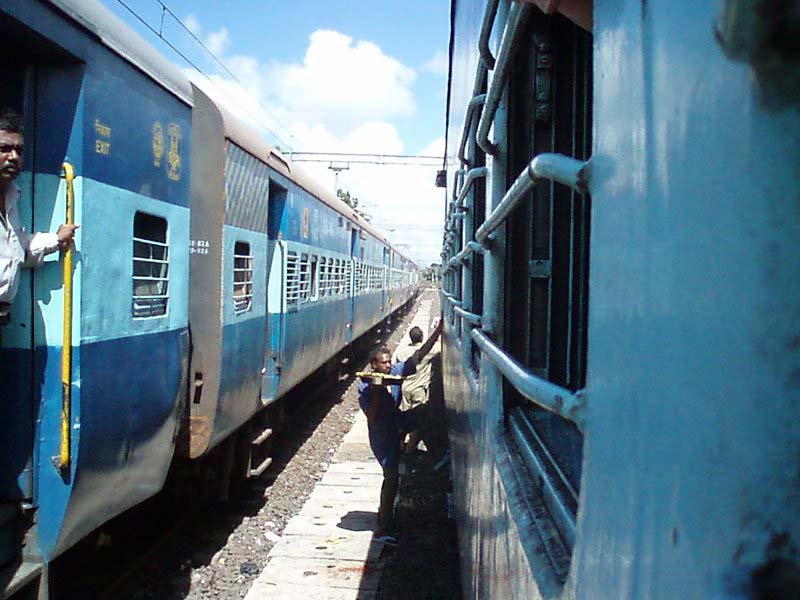

Some years ago I was a Fulbright Scholar in India for four months. During that time, I had many opportunities to see The Real India, up close, and personal, since I was not on the "tourist" circuit. I was in Mangalore, a  small port city on the western coast of southern India. It's in the state of Karnataka, which has a primarily agricultural economy; rice, coconuts, cashews and raisins are the main crops.
small port city on the western coast of southern India. It's in the state of Karnataka, which has a primarily agricultural economy; rice, coconuts, cashews and raisins are the main crops.
"Small" is a relative term: Mangalore is "small" by Indian standards, being 63rd in size rank...but at the time it had 400,000 residents, which makes it about the size of San Antonio, TX. In the USA it would be in the top ten. Nevertheless, it is small enough not to be on tourist maps. (Another reason it's not on these maps is because it has no tourist interest whatever, another reason I chose to go there.) In area the city proper is smaller than my home town of Blacksburg, VA. As you can imagine the population density is pretty high, and at times it feels as if everyone is standing in everyone else's pockets.
The Fulbright Office in India (headquarters are in New Delhi, of course) has an annual Mid-Year Conference, at which all the scholars in-country meet to talk about their work and experiences. Although I'd only arrived a week before the conference, I was invited to attend. It was held at a very plush place in the small state of Goa, the Fort Aguada Beach Resort. The resort is one of the Taj Group's hotels, a five-star operation, and definitely not The Real India, in any way, shape, or form. The best part was that the Fulbright people—that is to say, the US taxpayers—picked up the entire tab, and thank you all very much. (Actually, given the exchange rate of 40 Rupees to the dollar, it was a very good deal!) Rule #1: Never spend your own money when someone else's money is available; Rule #2: When you're spending someone else's money, go first class. I did.
 At the time, there was a threat of an air traffic controller's strike (labor strikes are a daily occurrence in India) so at the advice of my department head I opted to take the train, rather than flying up, as I'd originally planned. The distance was about 400 km (240 miles). Riding along with me were Mike Kuetemeier, another Fulbrighter, who is from Temple University; and his wife, Anula Shetty, who is Indian by birth (at left, with another passenger on the train, Master Wiggles' classmate). Even though I was a bit unsure about how to ride an India train, I figured Anula would be a valuable resource, so I agreed that this was probably a better option than flying.
At the time, there was a threat of an air traffic controller's strike (labor strikes are a daily occurrence in India) so at the advice of my department head I opted to take the train, rather than flying up, as I'd originally planned. The distance was about 400 km (240 miles). Riding along with me were Mike Kuetemeier, another Fulbrighter, who is from Temple University; and his wife, Anula Shetty, who is Indian by birth (at left, with another passenger on the train, Master Wiggles' classmate). Even though I was a bit unsure about how to ride an India train, I figured Anula would be a valuable resource, so I agreed that this was probably a better option than flying.
The train left Mangalore at 7:10 AM. Even after only a couple of weeks in India, I had already learned that getting someplace early is always wise. India is a place where you never can predict what might happen; and although the usual situation is that an airplane or train or other scheduled conveyance will be late in departure and arrival, on occasion a flight or train may be "pre-poned" (this word is actually used in "English as she is spoken" in India) i.e. it will leave early. So I was taking no chances. I got up at 4:30 and caught a cab to the train station in Mangalore.
 The Mangalore station turned out to be (as was every other train station I encountered) grimier and even more Third-World downscale than I'd expected, and by a substantial margin. As in the USA, rail travel is used most by the less-affluent strata of society (though to a much greater extent than is the case in America, middle-class Indians use it too). The Indian National Railways are not up to the standards of British Rail, SNCF, or the Swiss system (or even AMTRAK for that matter), but whatever its engineering or cosmetic deficiencies it's a functional transportation system that carries about nine million passengers per day. That is roughly the population of New York City and Philadelphia, combined. I didn't expect it to be like the Milan-Lucerne express. It wasn't.
The Mangalore station turned out to be (as was every other train station I encountered) grimier and even more Third-World downscale than I'd expected, and by a substantial margin. As in the USA, rail travel is used most by the less-affluent strata of society (though to a much greater extent than is the case in America, middle-class Indians use it too). The Indian National Railways are not up to the standards of British Rail, SNCF, or the Swiss system (or even AMTRAK for that matter), but whatever its engineering or cosmetic deficiencies it's a functional transportation system that carries about nine million passengers per day. That is roughly the population of New York City and Philadelphia, combined. I didn't expect it to be like the Milan-Lucerne express. It wasn't.
I tried to buy a first-class ticket; and was told no dice, it's a one-class train. And....that one class was "Indian Class." This meant that if I could find a seat, and if I could manage to keep it, I could have one, but otherwise, I'd stand up with everyone else. But there was no turning back: it was already too late to get to the airport in order to catch the flight.
Luckily we had arrived there early enough to get a seat. Mike and Anula met me at the station, where I had already bought 3 tickets—all of 47 rupees each (round trip, of course!) which worked out to about a dollar and half per person! In essence the railroad network in India is free, so it isn't surprising that for the average person it's the method of choice for travel. On a per-mile basis the Indian Railways are a great bargain, but it's true: you get what you pay for.
 The coaches to Goa were lined up on one "platform." Again, the term is misleading. A "platform" in this case was simply the dirt strip alongside the track. Although there were two real platforms for other trains, this one was a new run on the just-built Konkan Railway, so the railway authorities hadn't bothered to build a new wooden platform for it. We climbed up into the cars from the ground about 3 feet below, something of an athletic feat for me.
The coaches to Goa were lined up on one "platform." Again, the term is misleading. A "platform" in this case was simply the dirt strip alongside the track. Although there were two real platforms for other trains, this one was a new run on the just-built Konkan Railway, so the railway authorities hadn't bothered to build a new wooden platform for it. We climbed up into the cars from the ground about 3 feet below, something of an athletic feat for me.
Now, if I hadn't been told that it was in fact the Goa train, I'd have thought it was a collection of condemned cars awaiting breakup for scrap. Apparently the train had been made up of old, former "3rd-class" carriages. These had been administratively upgraded to the status of 2nd-class by the clever expedient of simply eliminating the distinction and no longer selling "3rd-class" tickets. The cars must surely have been painted when they first left the coachworks, but obviously nobody had bothered with repainting since, and it was anyone's guess how long ago they'd been new. Given the Indian climate and the all-pervasive dust, it probably wasn't all that long, not more than ten years. But these cars were so weather-beaten and had such a timeless look about them, if I'd been told they dated back to the British Raj I wouldn't have been surprised at all.
Inside they were worse than outside. They were every bit as dirty and as littered and as smelly as any movie image of an Indian train, and could have been used for a movie set for a remake of Gunga Din. Half an inch of solid grime covered everything, and I suspected that by the end of the day, that would include all the passengers, too (I was right). There was no air conditioning, of course; but there were at least sixty ceiling fans in each car, some of which did work, though not the ones near me. The cars were day coaches, with board seats covered in torn vinyl but lacking any sort of padding. Trash was everywhere on the floor. Nor was there any glass in the windows, presumably to facilitate ventilation. The windows themselves were barred, so that you couldn't even jump out, no matter how desperate you might get.
Before boarding, Mike had asked where the rest room was, and Anula pointed to the "platform" and said, "Just go there. Everyone does." So it proved. There were toilets on the train, the usual hole-in-the-floor Indian type; but I don't think we could have got to them, or that I'd have dared use them in any event. Thinking ahead, I resolved to limit my water intake and to pray for dehydration on the trip.
We did manage to find seats, and I think we were lucky. Although we were early, there were others who'd got there earlier still: fair numbers of people had come in the night before and were sleeping in the train to assure they had seats. After we'd settled in, I resolved not to leave my seat till I reached Goa, which turned out to be easier than I thought, since once we filled up there was no chance of my even getting out of the seat at all. The train left 30 minutes late (but made up the time on the run). While we waited to pull out I fanned away hundreds of mosquitoes rising from the swamp next to the tracks and the shanty town in it.
 By the time we left we had standees in the aisles, and in the vestibules at each end of all the cars. A few guys were hanging out the doors, though I don't think there was anyone on the roof on that particular train. To this ex-New Yorker, it was very much like riding the IRT subway at rush hour on a hot day. However, the passenger load at the start was only the beginning. After the first stop we had many, many more standees. At every subsequent stop more people got on, but no one ever got off. By the time we had made three stops the car was so packed it was more or less impossible to move, and I was thanking my foresight in getting that seat. Indians accept this as the normal condition: there's always room for one more, and if not, well, there's the roof, isn't there?
By the time we left we had standees in the aisles, and in the vestibules at each end of all the cars. A few guys were hanging out the doors, though I don't think there was anyone on the roof on that particular train. To this ex-New Yorker, it was very much like riding the IRT subway at rush hour on a hot day. However, the passenger load at the start was only the beginning. After the first stop we had many, many more standees. At every subsequent stop more people got on, but no one ever got off. By the time we had made three stops the car was so packed it was more or less impossible to move, and I was thanking my foresight in getting that seat. Indians accept this as the normal condition: there's always room for one more, and if not, well, there's the roof, isn't there?
At Udupi, the first town outside Mangalore, a huge pack of school kids got on. This was apparently a grade-school class on a group outing, and like everyone else, they were going all the way to Goa. The smaller spaces between the adult passengers were filled by stuffing them with Indian urchins and their keepers, until the whole car was jammed with humanity to the point of near-bursting. I was lucky enough to receive my very own urchin, whom I'll always think of as Young Master Wiggles. He was a cute kid about 8 or 9, plunked into the 6" space  between me and the old man on my right by his harassed schoolteacher. This lovely young woman smiled at me as she wedged him in, saying, "This is the most mischievous boy in my class," as she dropped him off, and that was the last I ever saw of her.
between me and the old man on my right by his harassed schoolteacher. This lovely young woman smiled at me as she wedged him in, saying, "This is the most mischievous boy in my class," as she dropped him off, and that was the last I ever saw of her.
To give him his due Young Master Wiggles was quiet; he didn't shout or yell. But on the other hand, he never stopped moving. He stayed wedged up against my right hip for the entire trip, squirming and kicking me in the foot. As he grew tired, he discovered that a well-padded foreigner is a convenient object to lean against when you want to nap, and my right thigh turned out to be a comfortable place for his pointy little elbow when he wanted to watch the scenery. After the first hour or so, my ass was getting more and more achy from the board seat; but there was no way to stretch out and get even remotely close to comfortable, especially with Master Wiggles doing his damnedest to get into my lap (something which he eventually succeeded in doing). If I shifted my weight to relieve the stress on one part, I drew resentful looks from my young seatmate, whose contemplative mood had been disturbed by my movements. If I leaned forward, when I leaned back, his head was behind me.
At every station, hawkers would come through the car, fighting their way through and literally climbing over the crowds and along the backs of the seats. Master Wiggles bought something to eat from every single one. He'd brought money along for the big class outing, and wasn't about to miss any nuance of the travel experience. Usually it was rice or some other slop wrapped in banana leaves, with the whole thing then wrapped in  newspaper. Sometimes it was potato chips, or cola, or candy. In addition to what he bought at the stops, he'd brought along his own bag of fruit, I suppose to make sure he didn't starve to death between stations. He found my leg to be the most convenient place to rest his orange and banana peels as he methodically stripped them off. In short, for the entire trip he grazed more or less constantly. When he wasn't eating he was wiggling and twitching and pushing. He would lean over to see out the window and practically sit on me to do it (this was the dodge he used to get up on my leg) and whenever he (or anyone else) ate anything, the disposal of the trash (newspapers, leaves, wrappers, whatever) was via the window on my left.
newspaper. Sometimes it was potato chips, or cola, or candy. In addition to what he bought at the stops, he'd brought along his own bag of fruit, I suppose to make sure he didn't starve to death between stations. He found my leg to be the most convenient place to rest his orange and banana peels as he methodically stripped them off. In short, for the entire trip he grazed more or less constantly. When he wasn't eating he was wiggling and twitching and pushing. He would lean over to see out the window and practically sit on me to do it (this was the dodge he used to get up on my leg) and whenever he (or anyone else) ate anything, the disposal of the trash (newspapers, leaves, wrappers, whatever) was via the window on my left.
At least when the train was moving the mosquitoes weren't a problem, because they were left behind; any that might have been trapped in the car probably were killed by the locomotive exhaust that blew in through the open windows. I daresay a coal-burning locomotive would have been worse, but breathing concentrated diesel fumes is no fun, either.
 Periodically we would go through tunnels, and the other passengers would do weird things. Every time we entered one, they would start to whistle out the windows. I don't know what this was for. Perhaps they just liked to hear the echoes off the rock walls, but it was an invariable routine. The tunnels had something to be said for them: they were cooler by a considerable margin than the open, so much so that I was willing to accept the increased concentration of diesel fumes that accumulated in the car while passing through them, in exchange for some relief from the heat. If a tunnel was of any length the car would fill up with fumes until it smelled like a bus garage; God knows what the carbon monoxide content in the air was, but had some of those tunnels been longer someone might have died of asphyxiation.
Periodically we would go through tunnels, and the other passengers would do weird things. Every time we entered one, they would start to whistle out the windows. I don't know what this was for. Perhaps they just liked to hear the echoes off the rock walls, but it was an invariable routine. The tunnels had something to be said for them: they were cooler by a considerable margin than the open, so much so that I was willing to accept the increased concentration of diesel fumes that accumulated in the car while passing through them, in exchange for some relief from the heat. If a tunnel was of any length the car would fill up with fumes until it smelled like a bus garage; God knows what the carbon monoxide content in the air was, but had some of those tunnels been longer someone might have died of asphyxiation.
This trip took seven hours, arriving at Goa exactly on time. As we tried to disembark, a thunderous herd of people waiting on the platform were also trying to get on. Some of them managed it, and promptly engaged in screaming matches with people on the train. I asked what was going on, and Anula explained that the people getting on at Goa had bought reserved seats; and they boarded only to find those seats already occupied by people who had no intention of leaving them.
Since Goa was the last stop, this didn't make any sense to me until she added that it's common practice to board a train at the next-to-last stop, and to grab a seat as soon as someone gets off, so as to have a seat for the run in the opposite direction! The level of yelling and complaining seemed likely to develop into a fair-sized riot. The three of us struggled off somehow, battering our way through the arguers and the bystanders who'd come  to watch the fun. We then found out that the train station is 50 km from the resort. One thing India does sensibly is cabs: they have fixed rates per kilometer, and the driver is required to show you the "government chart" dictating his maximum fare. It's a good system that cuts down on the many abuses that are common in other places. But cabs are out of the reach of ordinary Indians for long hauls: the 50-km ride, one-ninth of the distance from Mangalore, cost Rs 525!
to watch the fun. We then found out that the train station is 50 km from the resort. One thing India does sensibly is cabs: they have fixed rates per kilometer, and the driver is required to show you the "government chart" dictating his maximum fare. It's a good system that cuts down on the many abuses that are common in other places. But cabs are out of the reach of ordinary Indians for long hauls: the 50-km ride, one-ninth of the distance from Mangalore, cost Rs 525!
On arrival at the Fort Aguada Resort I took a shower, and quite literally washed off an oil film that had accumulated on my skin, along with the grit and dust that had found its way into my pores. The washcloth the hotel provided turned a dingy gray color during the process.
Travel is broadening; it teaches a lot about other people and other cultures, and anyone who has a genuine desire to see The Real India will certainly encounter it on the Mangalore-to-Goa run. But someone with a low tolerance for heat, dust, diesel smoke, body odor, and close physical contact with total strangers would be well advised to avoid second-class carriages on Indian railroads.
| HUNTING | GUNS | DOGS |
| FISHING & BOATING | TRIP REPORTS | MISCELLANEOUS ESSAYS |
| CONTRIBUTIONS FROM OTHER WRITERS|
| RECIPES |POLITICS |